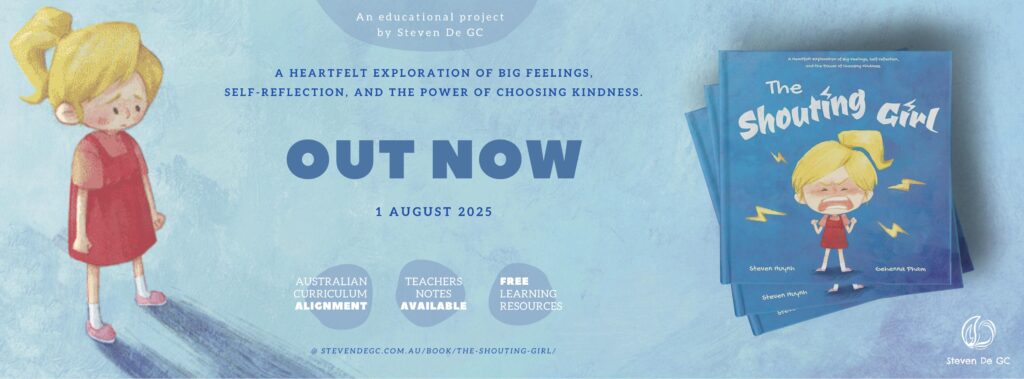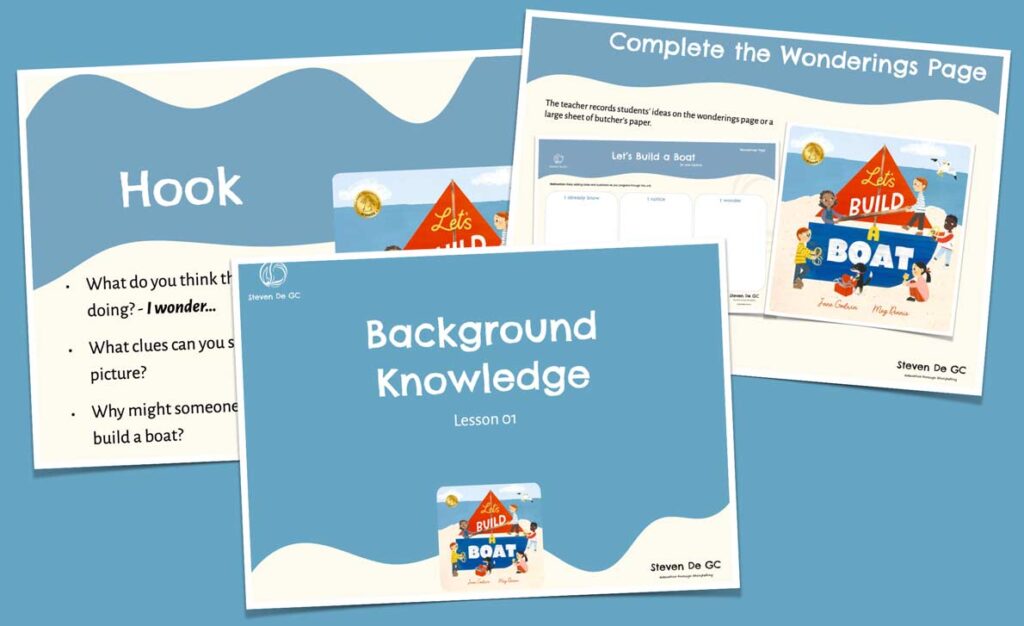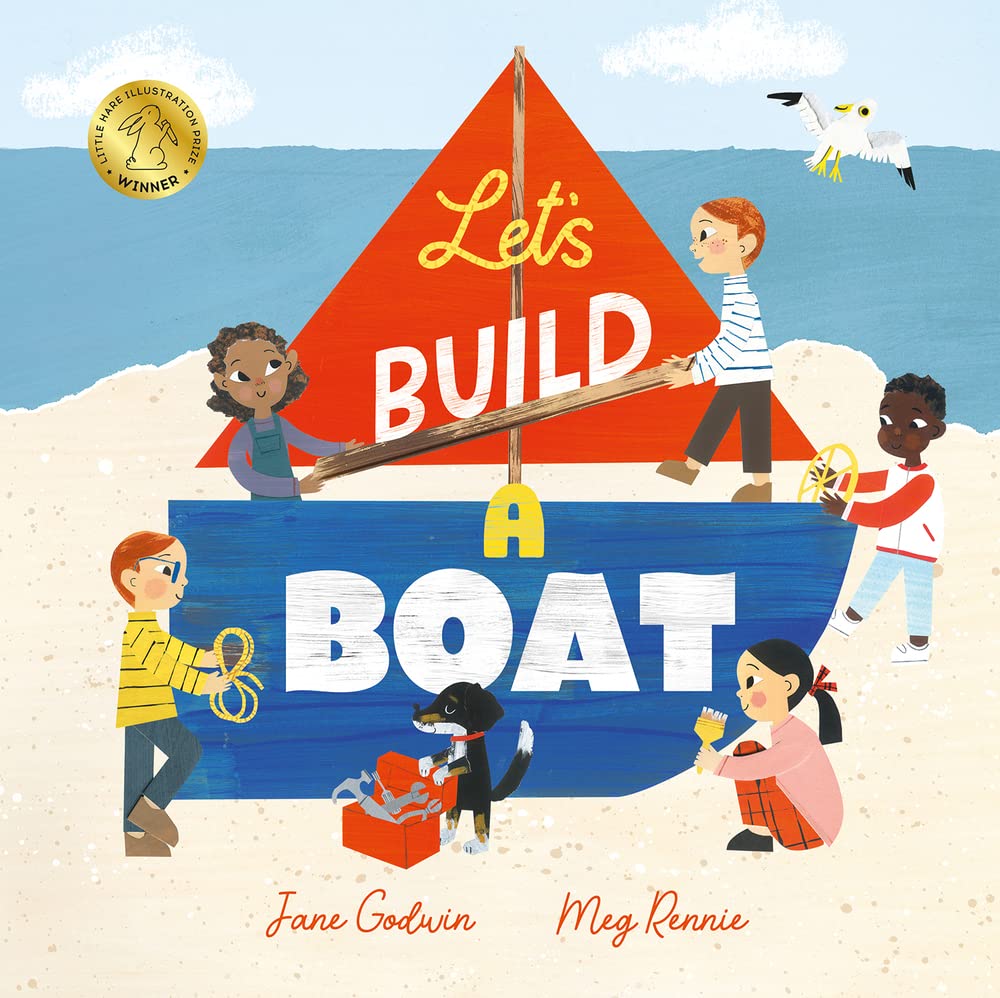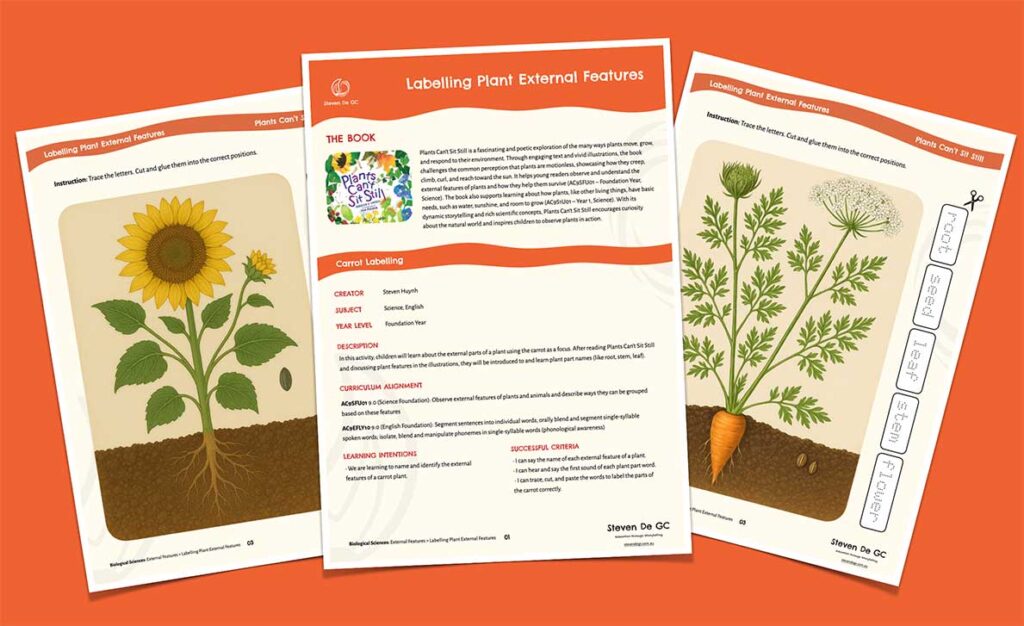Warm-Up: Prior Knowledge
- Ask students:
- “Have you ever made something?”
- “What was it?”
- “How did you feel when you made it?”
- Prompt for ideas like cubbies, cards, Lego, models, etc.
- Encourage 2–3 children to share and highlight pride, creativity, or effort.
Book Cover Prediction
- Show the cover of Let’s Build a Boat. Ask:
- “What do you think they are building?” “I wonder…”
- “What clues can you see in the picture?”
- “Why might someone want to build a boat?”
- Write a few student predictions or ideas on the wonderings page (butcher’s paper)
Video: Simple Boat Making
- Watch a short video: https://www.youtube.com/shorts/N44ZZ_dsvLI
- Afterwards, Discuss:
- “Do you think it’s easy or hard to make a boat?”
- “What materials or tools might the characters use?” – “I think… or I notice in the video…” (e.g., they’ll use wood, nails, and some kind of glue)
- Explain the topic we’re learning throughout the unit.
- Record students’ ideas about boats or anything about the cover on the wonderings page.
- Teacher can use a butcher’s paper instead of the provided template.
Students’ Wonders about the Story
- Records students’ inputs and wonders on the wonderings page:
- What do you think the story is going to be about? – “I wonder if the story is about…”
- Do you think they will use the same materials and tools that are used in the video?





![[T4R] Let’s Build a Boat Reading/Design Unit for Year 1/2 [T4R] Let’s Build a Boat Reading/Design Unit for Year 1/2](https://stevendegc.com.au/wp-content/uploads/2025/05/LetsBuildaBoat-T4R-Overview-Cover-1024x626.jpg)
![[T4R] Let’s Build a Boat: L11 Evaluation and Reflection [T4R] Let’s Build a Boat: L11 Evaluation and Reflection](https://stevendegc.com.au/wp-content/uploads/2025/05/LetsBuildaBoat-T4R-Lesson11-Cover-1024x626.jpg)
![[T4R] Let’s Build a Boat: L10 Summarising [T4R] Let’s Build a Boat: L10 Summarising](https://stevendegc.com.au/wp-content/uploads/2025/05/LetsBuildaBoat-T4R-Lesson10-Cover-1024x626.jpg)
![[T4R] Let’s Build a Boat: L9 Making Inferences [T4R] Let’s Build a Boat: L9 Making Inferences](https://stevendegc.com.au/wp-content/uploads/2025/05/LetsBuildaBoat-T4R-Lesson9-Cover-1024x625.jpg)
![[T4R] Let’s Build a Boat: L6 Writing a Boat-making Procedure [T4R] Let’s Build a Boat: L6 Writing a Boat-making Procedure](https://stevendegc.com.au/wp-content/uploads/2025/05/LetsBuildaBoat-T4R-Lesson6-Cover-1024x626.jpg)
![[T4R] Let’s Build a Boat: L5 Connecting to a Different Text [T4R] Let’s Build a Boat: L5 Connecting to a Different Text](https://stevendegc.com.au/wp-content/uploads/2025/05/LetsBuildaBoat-T4R-Lesson5-Cover-1024x626.jpg)
![[T4R] Let’s Build a Boat: L4 Literal Retrieval [T4R] Let’s Build a Boat: L4 Literal Retrieval](https://stevendegc.com.au/wp-content/uploads/2025/05/LetsBuildaBoat-T4R-Lesson4-Cover-1024x626.jpg)
![[T4R] Let’s Build a Boat: L3 Making Connections [T4R] Let’s Build a Boat: L3 Making Connections](https://stevendegc.com.au/wp-content/uploads/2025/05/LetsBuildaBoat-T4R-Lesson3-Cover-1024x625.jpg)
![[T4R] Let’s Build a Boat: L2 Making Predictions [T4R] Let’s Build a Boat: L2 Making Predictions](https://stevendegc.com.au/wp-content/uploads/2025/05/LetsBuildaBoat-T4R-L2-Cover-1024x627.jpg)

![[T4R] A Family is a Family is a Family: L6 Reflecting and Evaluating [T4R] A Family is a Family is a Family: L6 Reflecting and Evaluating](https://stevendegc.com.au/wp-content/uploads/2025/03/T4R-A-Family-is-a-Family-L6-Cover-1024x627.jpg)
Leave a Reply